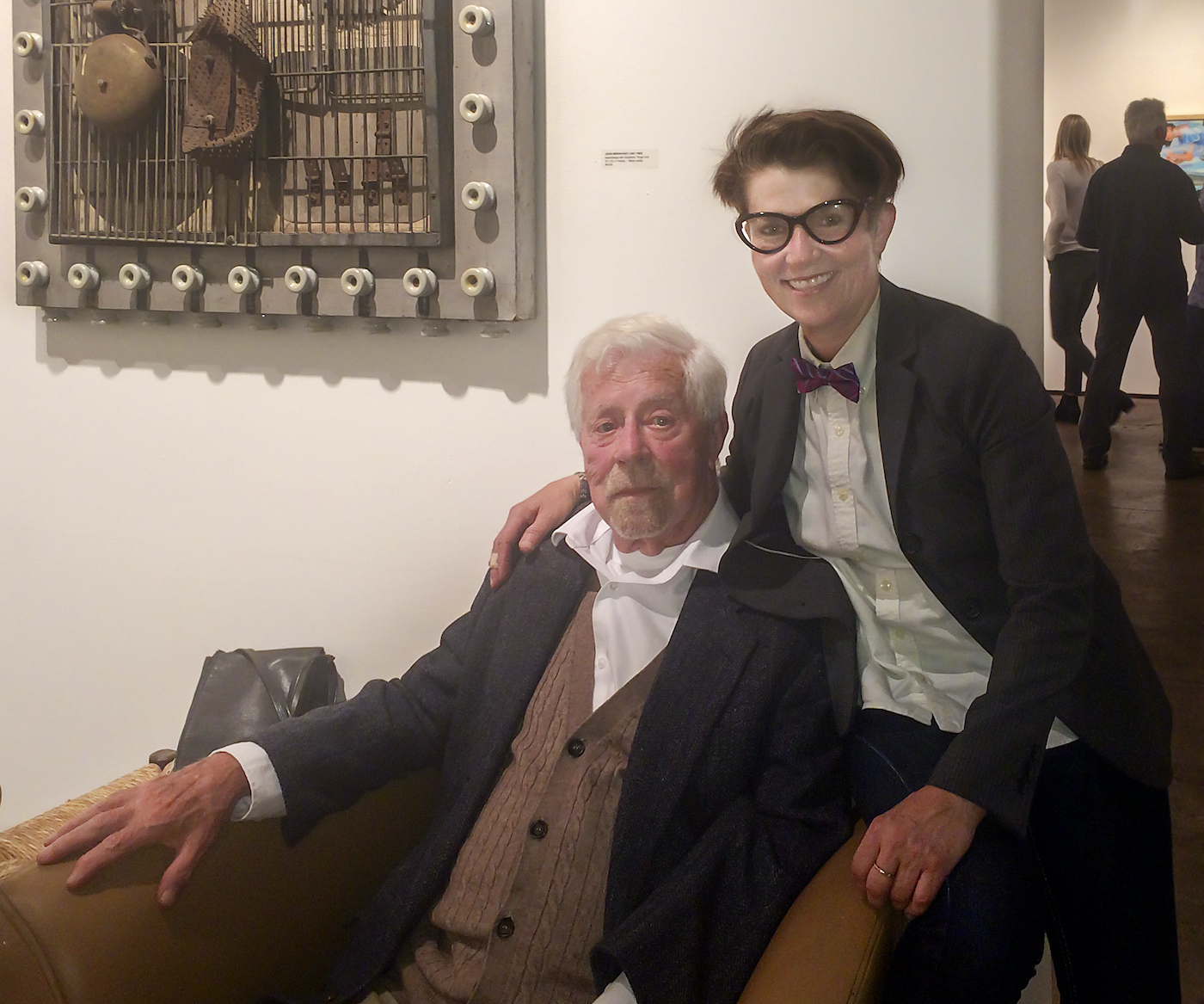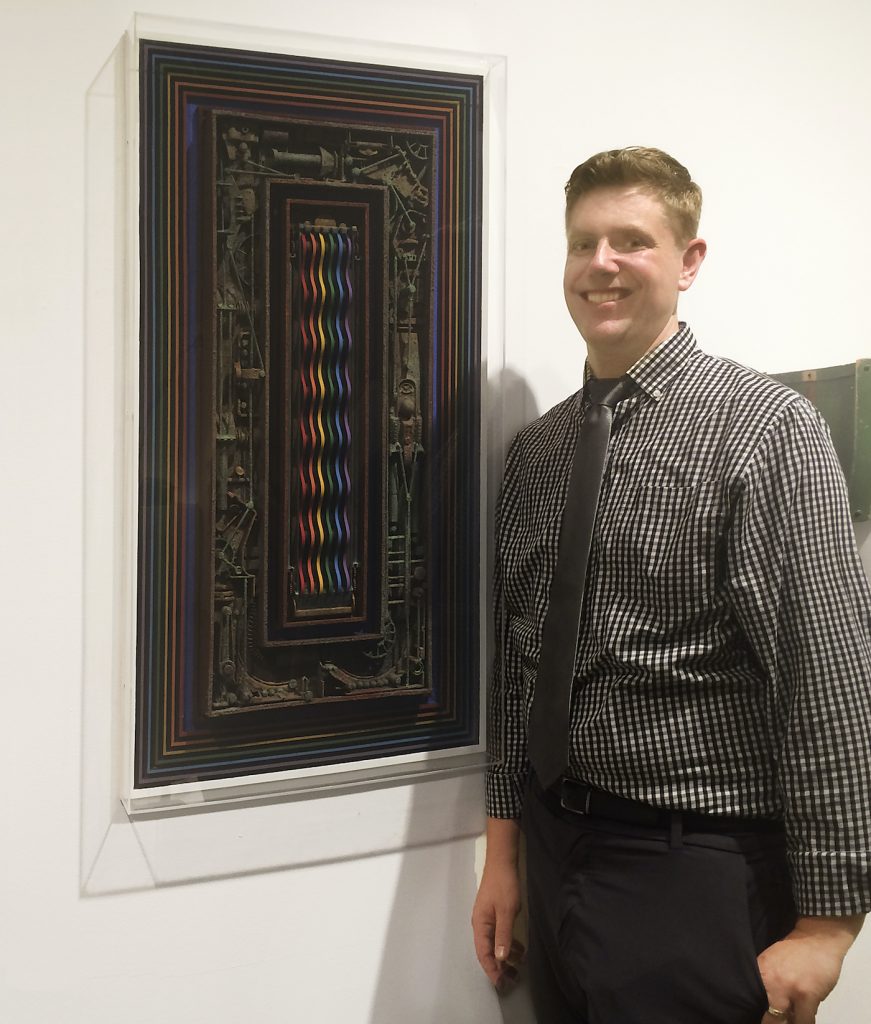Sullivan Goss Art + Postel-McEuen’s Music

Following two days of much-needed rain, the sun came through for October’s 1st Thursday art walk, humming with crowded streets, galleries, and clubs. The art headliner was the Sullivan Goss Gallery exhibit tracing the history of assemblage art in Santa Barbara from 1956-2018, aptly titled THE RED-HEADED STEPCHILD and curated by art historian and Gallery director of Sullivan Goss Jeremy Tessmer. There are 61 works on view in the gallery from 22 artists: Tony Askew, Tal Avitzur, John Bernhardt, William Dole, Peggy Ferris, Nancy Gifford, Inga Guzyte, Mary Heebner, Angela Holland, Frank Kirk, Philip Koplin, Dan Levin, Michael Long, Virginia McCracken, Ken Nack, Ron Robertson, Joe Shea, Elena Mary Siff, Susan Tibbles, Dug Uyesaka, Sue Van Horsen, and Howard Warshaw.
As always, Jeremy’s keen eye for layout and lighting of multiple artist and medium shows is par excellence. The exhibition has an even, calm flow with enough spacing to appreciate each work in its own view. The history of art is noted by the dates on the placards, and one can appreciate the range of assemblage art here, the converging of nuances that provide the artist’s message. The king in the room was Robertson accompanied by his daughter, talented chef and musician Edie. The elder of the exhibit, he was seated in an antique mustard-colored leather chair handing out DVDs of his works.
After photographing Ron and Edie, I posed Jeremy next to Ron’s “Rainbow Machine Model 20” piece. Although très occupé, Jeremy took time for an in-depth interview after the photo, opening with, “I’m happy that you intend to write something about THE RED-HEADED STEPCHILD. I think will long be thought of as a landmark exhibition for us.”

Q: What spawned an exhibition of local assemblage artists dating to 1956?
A: My contention is that assemblage/collage art are as widely practiced and as innate to our area’s visual culture as is plein air painting. I wanted to shine a light on that, with the hope that our community would make this part of the main narrative we tell ourselves and pass on about life here.
What was the artist selection criterion?
Three and a half years ago, I started an artist list centered around assemblage that I shared with the late Philip Koplin, Elena Mary Siff, and Dane Goodman. There were almost 50 names on the list. Of those, 20 are in this exhibition. Ultimately, I realized that I wouldn’t be able to get things from a number of artists for logistical reasons. To wit, I didn’t have space or time. I tried to outline a continuity and a historical arc for collage and assemblage in Santa Barbara – one that was full of familiar names so that people would realize that they already knew many of the main characters in this story. Although in some ways, this exhibition only skims the surface of these practices here in town. A lot of the artists in this exhibition are teachers, mentors, and curators. I also included a few up-and-comers that I find personally exciting.
What about the choice of the exhibition title?
The artist Sue Van Horsen came up with the title. I wanted to indicate that we have been marginalizing a certain art form here in town. I also wanted something a little racy, since much of the work of the late 1950s and early 1960s was pretty radical.
What works are most exemplary to the statement of the exhibit?
That’s a genuinely difficult question to answer. Our lone work by John Bernhardt from about 1960 is, I think, pretty revelatory in its way. Bernhardt was an artist who had trained at the John Heron School in Indianapolis, at the Fine Arts Center of Colorado Collage, at Columbia in New York, and in Mexico where he met José Clemente Orozco before he arrived in 1959. He made his first assemblage here from materials he found in our local thrift stores and junkyards. In 1961, he saw an Edward Kienholz exhibition in Los Angeles and realized that “there was magic in the air” around this kind of idea – that other people were also making art from found objects.
John died in 1963 at the age of 42 and was given a large retrospective at the Santa Barbara Museum of Art the next year. A museum director broadly associated with assemblage and Dada named Thomas Leavitt was in charge at the time. The Santa Barbara Museum of Art has a major piece by John. His story isn’t so well-known by the curators there and few of the artists I talked to knew of him, and yet, there he is. So, the practice is pretty deep. John’s work has also been in a number of important statewide surveys.
Anything else about the exhibit and the gallery’s commitment to local art?
As we continue to learn more about our community’s art history and American art history in general, we want to share what we find interesting and exciting with our patrons. I feel very strongly that we live in an artistically rich area but also one full of such well-educated and worldly people that our community sometimes takes a rather dismissive view of what’s happening “next door.” The truth is that the artists are also pretty worldly and well-educated. That they should choose to live in one a place that is desirable to some of the most affluent people in the world shouldn’t be a mark against them. We all agree: Santa Barbara is the place to be.
Indeed! The exhibit ends Sunday, October 14 – do go!
As a side note, the 1st Thursday music top pick was an impromptu gig by stellar musicians Jonathan McEuen and Steve Postell. McEuen zoned in from his Nasville-Colorado-Yosemite tour. Doing an acoustic guitar set, they traded solos and invited singer-songwriter Suzanne Paris [Dave Mason, Linda Rondstadt] to jam. Friends arrived throughout, bringing up Randy Tico on stand-up bass and Jason Libs on guitar. The set list included: “World Hunger” [Paris], “Every Woman” [Dave Mason], “Bad Weather” [Poco], and “Willin’ ” [Little Feat].
As always, McEuen kept the audience spellbound as he channeled Hendrix on guitar while singing in his 5-plus octave voice. Postel’s surprise gentle falsetto vocals, slide guitar, and killer licks shaped the performance. Ms Paris def showed her Grammy chops with sharply honed vocals and guitar. Although the FOH [front of house] was packed, there should’ve been a line down the street for this talent. Word Up: Live music here just kicked up 10 notches with gigs like this happening so frequently. Get out and #supportlocallivemusic
411: www.sullivangoss.com, exhibit on view through Sunday, October 14








You must be logged in to post a comment.